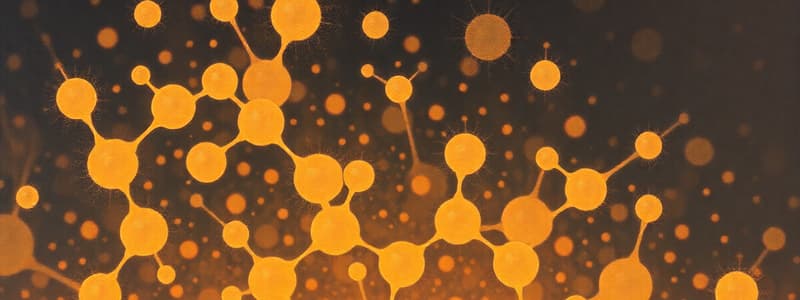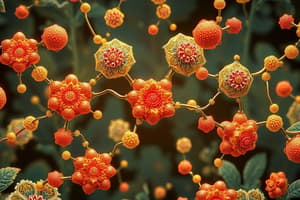Podcast
Questions and Answers
What is sucrose formed from?
What is sucrose formed from?
- Glucose and fructose (correct)
- Glucose and maltose
- Fructose and lactose
- Glucose and galactose
Which type of reaction leads to the formation of sucrose?
Which type of reaction leads to the formation of sucrose?
- Oxidation reaction
- Dehydration reaction (correct)
- Reduction reaction
- Hydrolysis reaction
What structure do the monomers of starch primarily consist of?
What structure do the monomers of starch primarily consist of?
- Sucrose monomers
- Fructose monomers
- Glucose monomers (correct)
- Galactose monomers
Which of the following roles do polysaccharides primarily serve in organisms?
Which of the following roles do polysaccharides primarily serve in organisms?
What is the major storage form of glucose in plants?
What is the major storage form of glucose in plants?
Which of the following statements about fructose is true?
Which of the following statements about fructose is true?
What are polypeptides primarily composed of?
What are polypeptides primarily composed of?
Which statement correctly describes proteins?
Which statement correctly describes proteins?
Which type of polysaccharide is amylopectin classified as?
Which type of polysaccharide is amylopectin classified as?
What functional groups do amino acids possess?
What functional groups do amino acids possess?
What kind of linkage occurs during the synthesis of sucrose?
What kind of linkage occurs during the synthesis of sucrose?
How do the properties of amino acids differ?
How do the properties of amino acids differ?
What is the total number of different amino acids that make up proteins?
What is the total number of different amino acids that make up proteins?
Which of the following amino acids is categorized as nonpolar?
Which of the following amino acids is categorized as nonpolar?
What is the role of the side chain, or R group, in an amino acid?
What is the role of the side chain, or R group, in an amino acid?
Which amino acid would be classified as polar?
Which amino acid would be classified as polar?
Which of the following statements about polypeptides is true?
Which of the following statements about polypeptides is true?
What is the predominant structure of monosaccharides in solution?
What is the predominant structure of monosaccharides in solution?
Which component is NOT a part of the standard structure of an amino acid?
Which component is NOT a part of the standard structure of an amino acid?
What happens to carbon 1 when glucose forms a ring structure?
What happens to carbon 1 when glucose forms a ring structure?
Which of the following correctly describes the configuration of carbon atoms in monosaccharides?
Which of the following correctly describes the configuration of carbon atoms in monosaccharides?
Which carbon atom is typically involved in forming the ring structure of glucose?
Which carbon atom is typically involved in forming the ring structure of glucose?
In the linear representation of monosaccharides, how many hydroxyl groups (OH) are typically present?
In the linear representation of monosaccharides, how many hydroxyl groups (OH) are typically present?
What effect does chemical equilibrium have on the linear and ring forms of monosaccharides?
What effect does chemical equilibrium have on the linear and ring forms of monosaccharides?
Which statement is true about the bonding in ring forms of glucose?
Which statement is true about the bonding in ring forms of glucose?
What role does carbon play in the structure of monosaccharides?
What role does carbon play in the structure of monosaccharides?
What are macromolecules primarily composed of?
What are macromolecules primarily composed of?
Which class of organic molecules is NOT considered a polymer?
Which class of organic molecules is NOT considered a polymer?
What is the process called by which monomers are joined to form polymers?
What is the process called by which monomers are joined to form polymers?
What is the role of dehydration reactions in the synthesis of polymers?
What is the role of dehydration reactions in the synthesis of polymers?
Which of the following best describes the term 'polymer'?
Which of the following best describes the term 'polymer'?
What occurs during a dehydration reaction?
What occurs during a dehydration reaction?
Which of the following statements about polymers is incorrect?
Which of the following statements about polymers is incorrect?
What type of reaction is primarily responsible for breaking down polymers into monomers?
What type of reaction is primarily responsible for breaking down polymers into monomers?
What are steroids primarily characterized by?
What are steroids primarily characterized by?
What role does cholesterol play in cellular structures?
What role does cholesterol play in cellular structures?
Which statement correctly describes proteins?
Which statement correctly describes proteins?
What function do enzymes provide within the cell?
What function do enzymes provide within the cell?
What is the role of the substrate in enzyme activity?
What is the role of the substrate in enzyme activity?
What happens during the enzymatic reaction as described in the content?
What happens during the enzymatic reaction as described in the content?
Which of the following is a precursor for some hormones?
Which of the following is a precursor for some hormones?
What is indicated by the presence of an active site in an enzyme?
What is indicated by the presence of an active site in an enzyme?
Flashcards are hidden until you start studying
Study Notes
Monosaccharides
- Monosaccharides can exist in linear or ring forms.
- Chemical equilibrium favors the formation of ring structures.
- In glucose, carbon 1 bonds to the oxygen on carbon 5 to create a ring.
Steroids
- Steroids are lipids characterized by a carbon skeleton with four fused rings.
- Cholesterol is a notable steroid found in cell membranes and serves as a precursor for some hormones.
Proteins: Structure and Function
- Proteins have diverse roles within cells, impacting various biological functions.
- Enzymes are specialized proteins that act as catalysts, accelerating chemical reactions.
Enzymes
- Enzymes contain an active site for substrate binding.
- Substrates are the reactants upon which enzymes act, leading to the formation of products.
Polypeptides
- Polypeptides are polymers made of amino acids.
- Proteins can consist of one or more polypeptides, determining their functional diversity.
Amino Acid Monomers
- Amino acids are organic molecules with both carboxyl and amino groups.
- The properties of amino acids vary due to different side chains known as R groups.
- There are 20 different amino acids that combine to form proteins.
Overview of Macromolecules
- Macromolecules are large and complex molecules formed by smaller units.
- Common macromolecules include carbohydrates, proteins, and nucleic acids.
Polymers and Monomers
- Most macromolecules are polymers, which are long chains built from repeating units (monomers).
- Polymers are synthesized through dehydration reactions, where water is removed to form bonds.
Polysaccharides
- Polysaccharides are polymers composed of sugar units and serve various functions in organisms.
- Starch is a major storage polysaccharide in plants, consisting entirely of glucose monomers.
- Starch is stored in chloroplasts and exists in two forms: amylose and amylopectin.
Studying That Suits You
Use AI to generate personalized quizzes and flashcards to suit your learning preferences.




